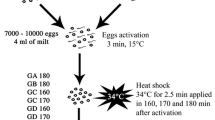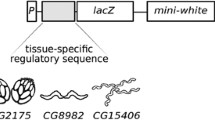Summary
In ring/rod-X-chromosome heterozygotes the ring-X-chromosome is frequently lost in the early cleavage mitoses. The resulting gynandromorphs are mosaics with female XX- and male XO-areas. The phenotypes of the recessive alleles on the rod-X-chromosome are expressed in the XO-areas.
The genemaroonlike (mal) on the X-chromosome influences the activity of the enzyme aldehyde oxidase. This fact was used to test the cell autonomy of aldehyde oxidase activity by histochemical methods in gynandromorphs of the genotypesR(1)2,In(1)w vC/y w mal andR(1)2,In(1)w vC/y w sn 3 lz 50e mal. The results show that in the cells of the imaginal Malpighian tubules the phenotypes ofwhite (w) andmaroonlike (mal) always occur together; XX-cells are pigmented and show aldehyde oxidase activity, whereas colorless XO-cells have no such enzyme activity (Figs. 1 and 2). This cell autonomy of aldehyde oxidase activity most likely applies also to the imaginal gut and the inner genitalia.
The distribution of XX- and XO-areas in the Malpighian tubules, the gut and the inner genitalia was examined in 355 gynandromorphs. Approximately half of the gynanders have Malpighian tubules with an XX/XO-mosaic (Table 1, 2 and 3). A large fraction of the mosaic tubules (62%; Table 4) shows a pattern of alternating small cell clusters of different genotypes. It is supposed that this pattern develops during the formation of the tubes, especially during their elongation. The number of primitive Malpighian cells is estimated to be about 140.
72% of the gynanders have mosaic guts (Table 1 and 5). The border between tissues of different genotypes is found very frequently in the posterior third of the anterior midgut (Fig. 3) and may correspond to the border between the tissues which develop from the anterior and posterior midgut rudiments. The estimates of the numbers of primitive cells for the gut structures are 2–3, as far as the crop, the cardia and the rectal valve are concerned, whereas a number of several hundred is estimated for the anterior as well as for the posterior midgut.
Mosaics were also found in the inner genitalia consisting of combinations of male and female structures. In 16 gynandromorphs the paragonia or the ductus ejaculatorius were mosaic (Fig. 4); i.e. in male structures with XO-genotype areas with aldehyde oxidase activity were found. Nothing is known about the origin of these XX-cells, but the possibility must be considered that in gynandromorphs cells of female genotype can participate in the development of male genital structures.
Similar content being viewed by others
Literatur
Bodenstein, D.: The postembryonic development ofDrosophila. In: Biology ofDrosophila, ed M. Demerec, p. 275–367. New York: Wiley 1950
Brown, S. W., Hannah, A.: An induced maternal effect on the stability of the ring-X-chromosome ofDrosophila melanogaster. Proc. nat. Acad. Sci. (Wash.)38, 687–693 (1952)
Courtright, J. B.: Polygenic control of aldehyde oxidase inDrosophila. Genetics57, 25–39 (1967)
Dickinson, W. J.: The genetics of aldehyde oxidase inDrosophila melanogaster. Genetics66, 487–496 (1970)
Dickinson, W. J.: Aldehyde oxidase inDrosophila melanogaster: A system for genetic studies on developmental regulation. Develop. Biol.26, 77–86 (1971)
Dickinson, W. J.: Genetically determined variations in the tissue distribution of an enzyme (Abstract). Genetics71 (Supp.), 14 (1972)
Dobzhansky, T.: Interaction between female and male parts in gynandromorphs ofDrosophila simulans. Wilhelm Roux' Arch. Entwickl.-Mech. Org.123, 719–746 (1932)
Ephrussi, B., Beadle, G. W.: A technique of transplantation forDrosophila. Amer. Naturalist70, 218–225 (1936)
Fausto-Sterling, A.: On the timing and the place of action during embryogenesis of the female-sterile mutantsfused andrudimentary Drosophila melanogaster. Develop. Biol.26, 452–463 (1971)
Garcia-Bellido, A., Merriam, J. R.: Cell lineage of the imaginal discs inDrosophila gynandromorphs. J. exp. Zool.170, 61–76 (1969)
Gehring, W. J., Nöthiger, R.: The imaginal discs ofDrosophila. In: Developmental systems: Insects, eds S. J. Counce and C. H. Waddington, vol. 2, p. 211–290. London-New York: Academic Press 1973
Gloor, H., Breugel, F. M. A. van, Volkers, W. S.: Some observations on variegation inDrosophila. Genetica38, 95–114 (1967)
Hotta, Y., Benzer, S.: Mapping of behaviour inDrosophila mosaics. Nature (Lond.)240, 527–535 (1972)
Janning, W.: Aldehyde oxidase as a cell marker for internal organs inDrosophila melanogaster. Naturwissenschaften59, 516–517 (1972)
Kroeger, H.: The genetic control of genital morphology inDrosophila. A study of the external genitalia of sex mosaics. Wilhelm Roux'Arch. Entwickl.-Mech. Org.151, 301–322 (1959).
Lindsley, D. L., Grell, E. H.: Genetic variations ofDrosophila melanogaster. Carnegie Inst. Wash. Publ.627 (1968)
Markert, C. L., Ursprung, H.: Developmental genetics. Engelwood Cliffs, New Jersey: Prentice Hall 1971
Miller, A.: The internal anatomy and histology of the imago ofDrosophila melanogaster. In: Biology ofDrosophila, ed M. Demerec, p. 420–534. New York: Wiley 1950
Nöthiger, R.: Differenzierungsleistungen in Kombinaten, hergestellt aus Imaginalscheiben verschiedener Arten, Geschlechter und Körpersegmente vonDrosophila. Wilhelm Roux' Arch. Entwickl.-Mech. Org.155, 269–301 (1964)
Nöthiger, R.: The larval development of imaginal disks. In: Results and problems in cell differentiation, eds H. Ursprung, R. Nöthiger, vol. 5, p. 1–34. Berlin-Heidelberg-New York: Springer 1972
Poulson, D. F.: Histogenesis, organogenesis and differentiation in the embryo ofDrosophila melanogaster Meigen. In: Biology ofDrosophila, ed M. Demerec, p. 168–274. New York: Wiley 1950
Ripoll, P.: The embryonic organization of the imaginal wing disc ofDrosophila melanogaster. Wilhelm Roux'Archiv169, 200–215 (1972)
Schultz, J.: The relation of the heterochromatic chromosome regions to the nucleic acids of the cell. Cold Spr. Harb. Symp. quant. Biol.21, 307–328 (1956)
Sonnenblick, B. P.: The early embryology ofDrosophila melanogaster. In: Biology ofDrosophila, ed M. Demerec, p. 62–167. New York: Wiley 1950
Stern, C.: The prospective significance of imaginal discs inDrosophila. J. Morph.67, 107–122 (1940)
Stern, C.: Genetic mosaics and other essays. Cambridge, Massachusetts: Harvard University Press 1968
Stern, C., Hadorn, E.: The relation between the color of testes and vasa efferentia inDrosophila. Genetics24, 162–179 (1939)
Stern, C., Hannah, A. M.: The sex combs in gynanders ofDrosophila melanogaster. Port. Acta biol. A. Vol. R. B. Goldschmidt, 798–812 (1950)
Strasburger, M.: Bau, Funktion und Variabilität des Darmtractus vonDrosophila melanogaster Meigen. Z. wiss. Zool.140, 539–649 (1932)
Sturtevant, A. H.: The claret mutant type ofDrosophila simulans: a study of chromosome elimination and of cell-lineage. Z. wiss. Zool.135, 323–356 (1929)
Author information
Authors and Affiliations
Additional information
Für anregende Diskussion danke ich Dr. H. J. Becker und Dr. R. Nöthiger sehr; ihnen sowie Dr. A. Garcia-Bellido und Dr. K. Heckmann bin ich für die kritische Durchsicht des Manuskripts dankbar. Frl. R. Münster und Frl. A. Termathe haben die Untersuchung durch zuverlässige technische Assistenz, die Deutsche Forschungsgemeinschaft durch großzügige finanzielle Unterstützung ermöglicht.
Rights and permissions
About this article
Cite this article
Janning, W. Entwicklungsgenetische Untersuchungen an Gynandern vonDrosophila melanogaster . W. Roux' Archiv f. Entwicklungsmechanik 174, 313–332 (1974). https://doi.org/10.1007/BF00579119
Received:
Issue Date:
DOI: https://doi.org/10.1007/BF00579119




